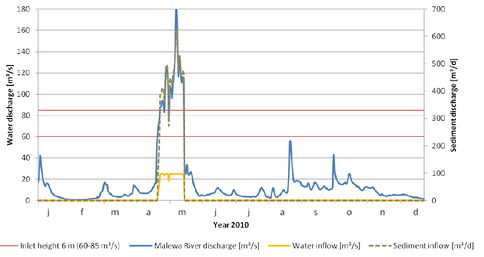Graduation Date: March 28, 2014 Graduation committee: University of Twente Dr.ir. D.C.M. Augustijn Dr.ir. P.R. van Oel | Rehabilitation of the former Northern Swamp, Lake Naivasha - Kenya On the modelling of the sediment trapping efficacy for two rehabilitation alternatives Erosion, induced by natural processes such as wind and rainfall and enhanced by anthropogenic activities such as agribusiness and deforestation, produces sediments that are carried downstream by rivers. Erosion and related problems also occur in the Lake Naivasha Basin, which is situated 80 km northwest of Nairobi in Kenya. The siltation affects the turbidity of the water with indirect influences on water use for human activities, fisheries, tourism and agriculture such as the flower business. The higher erosion rates which cause increasing sedimentation of the lake also cause greater inputs of nutrients and pollutants to the lake. These nutrients and pollutants threaten the ecological state of the lake. A possible solution to decrease the siltation of the lake is to rehabilitate the former Northern Swamp, a former wetland of about 4 km² north of Lake Naivasha, to retain sediments and prevent them from ending up in the lake. Marula Estates, a large commercialized agricultural landholding bordering the former Northern Swamp, initiated a rehabilitation project in 2009, and plans to extend this project by creating a wetland that will be fed with water from the Malewa River that enters Lake Naivasha also from the north. As an alternative to the proposed wetland, during this reserach also a meander was evaluated. The objective of this research was “To evaluate the functioning of two alternative rehabilitation alternatives, with in particular the sediment trapping efficacy, by modeling the sediment transport processes for various Malewa River discharges using a one-dimensional hydromorphodynamic model (SOBEK)”. To estimate the sediment trapping efficacy, for both alternatives the inflow of water and sediments from the Malewa River into the wetland/meander was determined. The results are presented in Figure 1. Due to the elevation of the inlet construction, only during Malewa River discharges exceeding 60 m³/s water can be diverted. Due to design requirements, the maximum water inflow was 25 m³/s.
Figure 1: Water and sediment inflow for a varying Malewa River discharge. For the wetland alternative it was calculated that 15% (i.e. 2900 ton) of the total sediment discharge in the Malewa River in 2010 would be diverted and trapped. For the meander alternative the trapping efficacy will be less. Both alternatives will improve the ecological quality but in different ways. |


